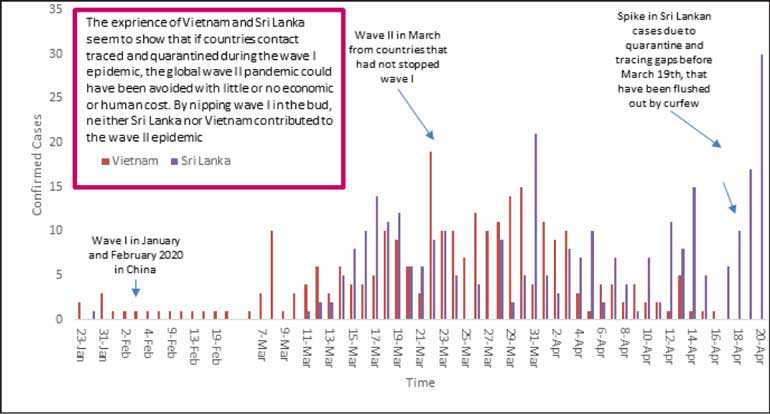Friday Dec 26, 2025
Friday Dec 26, 2025
Saturday, 25 April 2020 00:05 - - {{hitsCtrl.values.hits}}

Source: Ministry of Health, Sri Lanka; Ministry of Health, Vietnam
Voluntary testing, random testing of people in high-risk areas will increase the chance of asymptomatic index cases and members of clusters being discovered
By Fellows of the Advocata Institute
In dealing with the COVID-19 pandemic, Sri Lanka has been aggressively contact-tracing and later testing contacts of index cases that have turned up showing symptoms. Contact tracers in the health service and military have done a commendable job.
Initially Sri Lanka did not test contacts of index cases as soon as they were quarantined and also did not test quarantined persons before release. But these are gaps that have now been closed.
In addition, tight curfews have been placed in the country for weeks, for any exposed person that the contact tracers had missed, including anyone who came to the country before March 19 when the airport was closed, to develop symptoms and come to the hospital.
Several large clusters including the Bandaranaike Pura cluster relating to an index case that returned from India on 12 March, as well as the cluster from a case found in Suduwella Ja-Ela during curfew shows that the strategy was useful.
Current testing strategy is dependent on symptomatic cases
The current contact tracing strategy has a serious flaw in that it is too dependent on symptomatic cases and there is no way to detect an infected index case that is asymptomatic.
The best practice adopted in the countries with the most success is to trace at least three levels of contacts (F1, F2, F3) of an index case (F0). If there are confirmed cases at any given level, the next level is traced, quarantined and tested.
The longer the delay in discovering the index patient, the higher the chance that the disease has spread to multiple levels. Each level expands exponentially, therefore time is of the essence.
Contact tracers wait for index cases to show up in the hospital with symptoms to find the contact levels to kickstart the tracing process.
Authorities also wanted to get all index cases to state hospitals where they are able to exercise tight control and prevent further spread.
In a situation where tight curfew is imposed, this may be acceptable as the exponential expansion of new levels of contacts is stopped and the cluster is localised to where people can move around in houses close by.
However, it will not be the case when curfew is lifted.
High-Risk Groups during curfew and after
Even during curfew there are several high-risk groups that may get infected. These are delivery personnel, postmen, drivers and cleaners of vehicles, as well as medical staff and cleaning staff at hospitals.
Once curfew is lifted, the front office staff of any institution including airports, quarantine workers, cleaning staff, people working in economic centres, and drivers may be exposed to higher risks.
Those in driving/delivery related jobs in particular would also be in a position to spread the disease faster and to a greater area.
After curfew is lifted the government could sample test people in high-risk areas.
These include front office staff of hotels or any company, cleaning staff, transport and delivery personnel, restaurant/supermarket workers, taxi, truck, and other vehicle drivers and sex workers.
Voluntary and private random testing
Sri Lanka has imposed a price control on PCR testing. This price control does not account for the costs of personal protective equipment, the cost of medical staff, and the safe disposal of medical waste.
If the concerns of authorities are that hospitals could get infected, testing and sample collections could be done outside of private hospitals.
Removing the price control would allow competition to drive the cost down, and would allow the private sector to expand testing capacity.
Opportunities should be provided for companies to negotiate bulk discounts and multiple validated testing points should be allowed. Companies and employees could be encouraged to share the cost.
To reduce the cost on the government, opportunities should be provided for voluntary testing and testing at the cost of the employer; especially for front office staff and sample testing of factory workers.
This way any index cases that have slipped through the net and any second contacts of index cases who have since recovered could be discovered.
Under the current testing strategy there is zero chance of an asymptomatic person being discovered by authorities. Since the growth of a cluster is exponential, time is of the essence.
People may require a test for a variety of reasons.
Any individual who does not have symptoms but may feel that he/she was exposed due to going to a crowded place or any other high-risk location, that they have COVID-19 should have an opportunity to get a PCR test from at his or her own expense, preferably through a drive-through system.
Any individual who has to look after an elderly person or visit an elderly person may have a need for a test.
Many countries, including Korea are already asking for pre-flight tests from foreign visitors. The current state testing regime there is no opportunity for anyone to get a test.
Drawing from the process adopted in countries like the UAE, results could be sent by text messages and other online methods. The same could be shared with authorities to construct a live map without burdening the public sector.